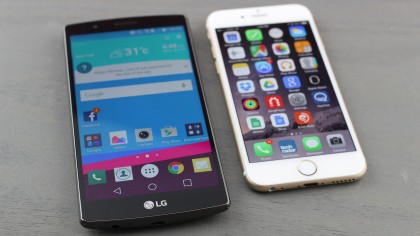3 reasons Apple should always keep the iPhone home button
No iPhone home button? Go home, Apple – you're drunk

The iPhone home button is where my heart is, which is why it pains me to see today's rumors indicate Apple is working on a way to get rid of this clicky input.
I see the trade-offs. More screens space and less "needless" bezel for future iPhone models. An on-screen button also means fewer parts and therefore fewer repair AppleCare jobs.
That's all well and good, but the substitute isn't worth it. Software buttons aren't as easy to use without the tactile feedback of pressing something inward.
An iPhone without a home button is unlikely to come to the iPhone 6S, which may be more of an iterative update. But I can think of multiple reasons it shouldn't debut in the iPhone 7, either .
1. Makes iPhone different from Android
I like Android phones. I'm a fan of the Moto X design, which came to the Nexus 6 in an even bigger form factor last year. I gave both high praise despite having on-screen buttons.

Likewise, the LG G4, HTC One M9 and Sony Xperia Z4 are all designed to be nearly bezel-free by skipping out on physical buttons and expanding their display sizes.
But that doesn't mean I want the new iPhone to sacrifice its thumb-sized input for an elongated display, even if that bigger display doesn't make the actual phone's dimensions any bigger.
Sign up for breaking news, reviews, opinion, top tech deals, and more.
A physical home button has always been part of the iPhone design. I want the next iPhone to be more like Android in some ways, but this is not what I had in mind.
2. The no-look click
I really like Samsung's approach here. It uses a thinner home button in the Samsung Galaxy S6 and Galaxy S6 Edge, giving me a happy medium and top pick for our best phone list.

In addition to returning to the home screen, is acts as a fingerprint sensor and, with a double click, speedily opens up the camera app. Holding it down leads to the Google Now menu.
Try doing that with an on-screen button. All of a sudden, that no-look mechanic isn't an option, requiring your eyes to look down at the screen more than they already do.
3. Disappearing physical buttons are a bad trend
Physical buttons are on the endangered "specs" list, and like a lot of new trends, I don't much care for it. Maybe I'm just getting old, but my fingers like knowing what I'm pressing.
Apple's fingerprints are already all over the murder weapon - it axed the mute switch on the iPad Air 2 in favor of an on-screen mute toggle. The next iPhone could be in for the same.

The mute switch is one of the iPhone features I like that you won't find on Android. Could it and an on-screen home button be the next things Apple adopts from Google?
For current iPhone owners without Android experience, remember when you'd toggle a big on and off switch on an older game console like the N64? Now think about the PS3 or PS4.
Haptic feedback buttons are hardly a solution. How many times did I mean to turn off my PS4 and reset it instead? The even smaller, harder-to-see buttons of the PS4 made things worse.
That's the sort of interface I expect from a new iPhone without a home button: confusing and not always working well. I have enough problems with the on-screen keyboard ever since autocorrect seemingly became dumber with the iOS 8.3 update.
Let's get physical
Let's get real. I'm going to buy the next iPhone and the one after that and the one after that, whether there's an on-screen button or a physical one.
I'm just a fan of phones, and while I rate the current Samsung Galaxy S6 higher than the iPhone 6 by one place on our best phones ranking, Apple makes a great mobile device.
I'll buy it, but I don't have to like it.
